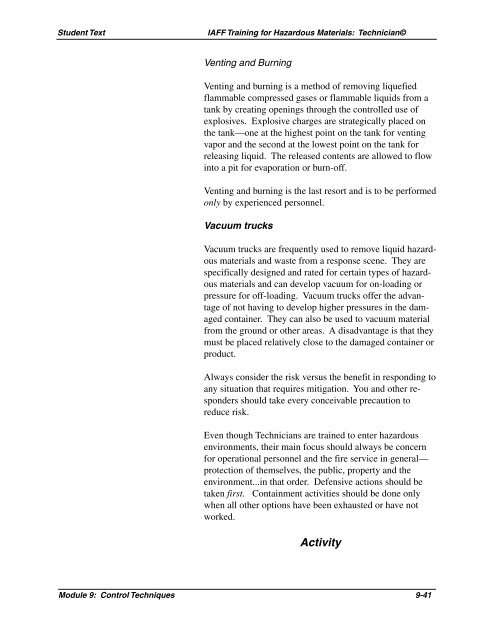Module 9: Control Techniques - International Association of Fire ...
Module 9: Control Techniques - International Association of Fire ...
Module 9: Control Techniques - International Association of Fire ...
You also want an ePaper? Increase the reach of your titles
YUMPU automatically turns print PDFs into web optimized ePapers that Google loves.
Student Text IAFF Training for Hazardous Materials: Technician©<br />
Venting and Burning<br />
Venting and burning is a method <strong>of</strong> removing liquefied<br />
flammable compressed gases or flammable liquids from a<br />
tank by creating openings through the controlled use <strong>of</strong><br />
explosives. Explosive charges are strategically placed on<br />
the tank—one at the highest point on the tank for venting<br />
vapor and the second at the lowest point on the tank for<br />
releasing liquid. The released contents are allowed to flow<br />
into a pit for evaporation or burn-<strong>of</strong>f.<br />
Venting and burning is the last resort and is to be performed<br />
only by experienced personnel.<br />
Vacuum trucks<br />
Vacuum trucks are frequently used to remove liquid hazardous<br />
materials and waste from a response scene. They are<br />
specifically designed and rated for certain types <strong>of</strong> hazardous<br />
materials and can develop vacuum for on-loading or<br />
pressure for <strong>of</strong>f-loading. Vacuum trucks <strong>of</strong>fer the advantage<br />
<strong>of</strong> not having to develop higher pressures in the damaged<br />
container. They can also be used to vacuum material<br />
from the ground or other areas. A disadvantage is that they<br />
must be placed relatively close to the damaged container or<br />
product.<br />
Always consider the risk versus the benefit in responding to<br />
any situation that requires mitigation. You and other responders<br />
should take every conceivable precaution to<br />
reduce risk.<br />
Even though Technicians are trained to enter hazardous<br />
environments, their main focus should always be concern<br />
for operational personnel and the fire service in general—<br />
protection <strong>of</strong> themselves, the public, property and the<br />
environment...in that order. Defensive actions should be<br />
taken first. Containment activities should be done only<br />
when all other options have been exhausted or have not<br />
worked.<br />
Activity<br />
<strong>Module</strong> 9: <strong>Control</strong> <strong>Techniques</strong> 9-41
















